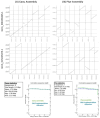Fully resolved assembly of Cryptosporidium parvum
- PMID: 35166336
- PMCID: PMC8848321
- DOI: 10.1093/gigascience/giac010
Fully resolved assembly of Cryptosporidium parvum
Abstract
Background: Cryptosporidium parvum is an apicomplexan parasite commonly found across many host species with a global infection prevalence in human populations of 7.6%. Understanding its diversity and genomic makeup can help in fighting established infections and prohibiting further transmission. The basis of every genomic study is a high-quality reference genome that has continuity and completeness, thus enabling comprehensive comparative studies.
Findings: Here, we provide a highly accurate and complete reference genome of Cryptosporidium parvum. The assembly is based on Oxford Nanopore reads and was improved using Illumina reads for error correction. We also outline how to evaluate and choose from different assembly methods based on 2 main approaches that can be applied to other Cryptosporidium species. The assembly encompasses 8 chromosomes and includes 13 telomeres that were resolved. Overall, the assembly shows a high completion rate with 98.4% single-copy BUSCO genes.
Conclusions: This high-quality reference genome of a zoonotic IIaA17G2R1 C. parvum subtype isolate provides the basis for subsequent comparative genomic studies across the Cryptosporidium clade. This will enable improved understanding of diversity, functional, and association studies.
Keywords: Cryptosporidium; assembly; assembly comparisons; nanopore.
© The Author(s) 2022. Published by Oxford University Press GigaScience.
Conflict of interest statement
F.J.S. has presented at both ONT- and Pacific Biosciences–sponsored conferences. The authors declare that they have no other competing interests.
Figures



References
-
- Dong S, Yang Y, Wang Y, et al. Prevalence of Cryptosporidium infection in the global population: a systematic review and meta-analysis. Acta Parasitol. 2020;65(4):882–9. - PubMed
-
- Fayer R, Morgan U, Upton SJ. Epidemiology of Cryptosporidium: transmission, detection and identification. Int J Parasitol. 2000;30(12-13):1305–22. - PubMed
-
- Fayer R. Cryptosporidium: a water-borne zoonotic parasite. Vet Parasitol. 2004;126(1-2):37–56. - PubMed
Publication types
MeSH terms
Grants and funding
LinkOut - more resources
Full Text Sources
Medical
Molecular Biology Databases

